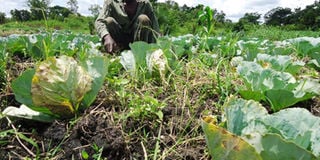Prime
Farmers count losses over black rot disease in cabbage

A farmer shows the extent of the damage to his cabbages. Mukono and Kayunga districts have been hit by the black rot disease, which affects vegetables like cabbage. PHOTO BY FRED MUZAALE
What you need to know:
Large amount of cabbages have been lost, thereby reducing the income farmers expected from their harvests.
Vegetable farmers, especially those who grow cabbages in Kayunga and Mukono districts are counting losses after a disease, which has been identified as the black rot disease, hit these areas.
According to Mr James Rwebikire, an agricultural expert, the disease is caused by fungi or bacteria and is locally known as kisanja. It produces dark brown discoloration in leaves and they start to decay.
Most prone
Though common in cabbages, Mr Rwebikire says, the disease affects almost all crops in the vegetable family. It manifests as a yellow V-shaped lesion at the leaf margin and as the diseased area expands, it turns brown.
The veins in the affected area may appear black and the leaf eventually collapses.
“The disease affects the crop’s ability to manufacture its own food (photosynthesis) and water movement in the crops is also affected, leading to withering and eventual death,” he says.
Cabbages, which are most prone, are those grown on overcultivated soils. The soils can be only be identified by experts when soil samples are checked.
One of the farmers who has lost his cabbages to the disease, Twaha Kakooza of Kyampisi village, Kayunga Sub-county, says he had planted four acres of the crop and was expecting about Shs18m from the harvest. However, he only managed to get Shs5m.
Moisture content
Another farmer, Patrick Musaazi, says his cabbages were infected while still in the nursery bed. “This disease is frustrating us because we had embarked on growing vegetables which are marketable but we have instead incurred losses.”
Rwebikire points out that the disease can be controlled by use of fertilisers, especially the inorganic ones like Super glow, Miracle and Vegmax, because the health of plants will be maintained.
He also advises that a farmer can increase on the number of times he or she irrigates the crop in a day so that the moisture content in the soil is increased.
Control the disease
Increases in the spacing between each cabbage especially if the disease is detected when the cabbage is still in the nursery bed can also help control the spread of the disease.
Mr Rwebikire says planting healthy seeds and crop rotation that excludes planting of crucifers (vegetables) can help control the disease.




